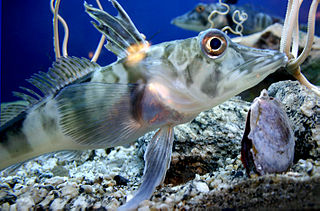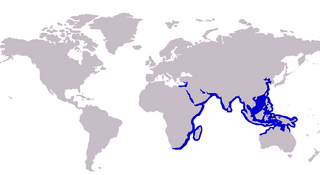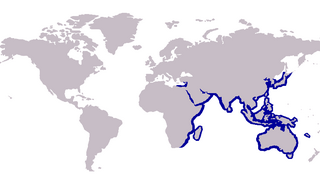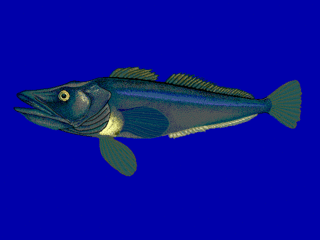
The crocodile icefish or white-blooded fish comprise a family (Channichthyidae) of notothenioid fish found in the Southern Ocean around Antarctica. They are the only known vertebrates to lack hemoglobin in their blood as adults. Icefish populations are known to reside in the Atlantic and Indian sectors of the Southern Ocean, as well as the continental shelf waters surrounding Antarctica. Water temperatures in these regions remain relatively stable, generally ranging from −1.8 to 2 °C. One icefish, Champsocephalus esox, is distributed north of the Antarctic Polar Frontal Zone. At least 16 species of crocodile icefish are currently recognized, although eight additional species have been proposed for the icefish genus Channichthys.
Salangidae, the icefishes or noodlefishes, are a family of small osmeriform fish, related to the smelts. They are found in Eastern Asia, ranging from the Russian Far East in the north to Vietnam in the south, with the highest species richness in China. Some species are widespread and common, but others have relatively small ranges and are threatened. Depending on species, they inhabit coastal marine, brackish or fresh water habitats, and some are anadromous, only visiting fresh water to spawn.

The spinner shark is a type of requiem shark, in the family Carcharhinidae, named for the spinning leaps it makes as a part of its feeding strategy. This species occurs in tropical and warm temperate waters worldwide, except for in the eastern Pacific Ocean. It is found from coastal to offshore habitats to a depth of 100 m (330 ft), though it prefers shallow water. The spinner shark resembles a larger version of the blacktip shark, with a slender body, long snout, and black-marked fins. This species can be distinguished from the blacktip shark by the first dorsal fin, which has a different shape and is placed further back, and by the black tip on the anal fin. It attains a maximum length of 3 m (9.8 ft).
The wildlife of Japan includes its flora, fauna, and natural habitats. The islands of Japan stretch a long distance from north to south and cover a wide range of climatic zones. This results in a high diversity of wildlife despite Japan's isolation from the mainland of Asia. In the north of the country, north of Blakiston's Line, there are many subarctic species which have colonized Japan from the north. In the south there are south-east Asian species, typical of tropical regions. Between these areas lies the temperate zone which shares many species with China and Korea. Japan also has many endemic species that are found nowhere else in the world, making it home to many endangered/rare species.

The oriental trumpeter whiting, Sillago aeolus, is a widely distributed species of benthic inshore fish in the smelt-whiting family. The species ranges from east Africa to Japan, inhabiting much if the southern Asian and Indonesian coastlines. Its morphology is very similar to other species within the genus Sillago, with a long, compressed body and silvery overall colour. It can be distinguished from its relatives by colour patterns and particularly swim bladder morphology, which helps define most species of Sillago. S aeolus is a benthic predator, consuming a variety of crustaceans and polychaetes. As with most members of the smelt whiting family, it is important to small coastal fisheries in various areas of its range.

The southern school whiting, Sillago bassensis, is a common species of coastal marine fish of the smelt-whiting family that inhabits the south and south-west coasts of Australia. Its distribution overlaps a number of other common sillaginids, with careful observation of anatomical features occasionally needed to distinguish between species. The southern school whiting is closely related to the eastern school whiting, Sillago flindersi, and initially were thought to be all one species. The species inhabits both shallow inshore sandy waters, as well as deeper offshore waters, with a transition of habitats occurring with increasing age. It is a predatory fish, taking a variety of crustaceans, polychaetes and bivalves as prey. It reaches sexual maturity at three years of age, and spawns multiple times between December and April. The southern school whiting is commonly caught by commercial and recreational fishermen, often while fishing for related species, especially the sought after King George whiting. The species is marketed fresh in southern Australia.
The ariakehimeshirauo, Neosalanx reganius, is a species of icefish in the family Salangidae endemic to Japan. It is only known from Midori and Chikugo Rivers in Kyushu. Its maximum total length is 63 mm (2.5 in), and has a lifespan of about one year. It seems to be relatively rare in its limited habitat, and is classified as an endangered species by IUCN.
Neosalanx is a genus of icefishes native to Eastern Asia, ranging from Korea, through Japan and China, to Vietnam. They inhabit coastal marine waters, estuaries and river basins. There are both species that are threatened and species that are widespread.

The shrimp scad, is a species of widespread tropical marine fish of the jack family, Carangidae. The shrimp scad is widely distributed in the tropical and subtropical western Indian Ocean and areas of the eastern Pacific Ocean, ranging from South Africa in the west to Hawaii in the east, including Japan and Australia to the north and south. The species is commonly found on inshore reefs and sandy substrates. It has the common body profile of a scad, and may be difficult to differentiate from others in the genus Alepes. It is one of the larger scads, growing to 40 cm, but often is encountered at much smaller sizes. The shrimp scad often forms large schools, and is carnivorous, consuming a variety of crustaceans and small fish. It is of moderate importance to fisheries throughout its range.

The northern whiting, also known as the silver whiting and sand smelt, is a marine fish, the most widespread and abundant member of the smelt-whiting family Sillaginidae. The northern whiting was the first species of sillaginid scientifically described and is therefore the type species of both the family Sillaginidae and the genus Sillago. The species is distributed in the Indo-Pacific region from South Africa in the west to Japan and Indonesia in the east, also becoming an invasive species to the Mediterranean through the Suez Canal. The northern whiting inhabits coastal areas to 60 m, but is most often found in shallow water around bays and estuaries, often entering freshwater. It is a carnivore, taking a variety of polychaetes and crustaceans. The species is of major economic importance throughout the Indo-Pacific. It is most frequently taken by seine nets and cast nets and marketed fresh.

Smelt-whiting is the common name for various species of the family Sillaginidae. The Sillaginidae are distributed throughout the Indo-Pacific region, ranging from the west coast of Africa to Japan and Taiwan in the east, as well occupying as a number of small islands including New Caledonia in the Pacific Ocean. Well known members of this family include King George whiting, Japanese whiting, northern whiting, sand whiting and school whiting.

The mackerel icefish is a benthopelagic species of fish found in the Southern Ocean and the southernmost waters of the Atlantic Ocean. They are mainly to be found near Heard and McDonald Islands, Îles Kerguelen and islands in the south Atlantic such as South Georgia and Bouvet Island. The species also inhabits the northern waters of the Antarctic Peninsula. They live at depths of 0–700 metres (0–2,297 ft), but are commonly found at depths of 30 to 250 metres.

Aphia minuta, the transparent goby, is a species of the goby native to the northeastern Atlantic Ocean where it can be found from Trondheim, Norway to Morocco. It is also found in the Mediterranean, Black Sea and the Sea of Azov. It is a pelagic species, inhabiting inshore waters and estuaries. It can be found at depths of from the surface to 97 metres (318 ft), though it is usually found at 5 to 80 metres, over sandy and muddy bottoms and also in eelgrass beds. This species can reach a length of 7.9 centimetres (3.1 in) TL. It is an important species to local commercial fisheries. It is currently the only known member of its genus.

The blackfin seabass is a Perciforme fish in the family lateolabracidae, found primarily in the shallow waters of the Pacific coast of Asia, in Japan and in South Korea. There are only two species in the genus Lateolabrax, known as Asian seabasses. As a perciforme, the blackfin seabass is among the largest order of fish in the ocean. Blackfin seabass live in shallow, tidal or rocky surf zones, partially as a way to escape competition with the Japanese seabass Lateolabrax japonicus, a close and almost identical relative of theirs, and partially for the breeding opportunity in brackish water by the mouths of rivers.
Hemisalanx brachyrostralis is a species of icefish endemic to the Yangtze basin, China. It is the only known species in the genus Hemisalanx, after Hemisalanx prognathus was moved to genus Salanx. In a study of the five freshwater icefish species in the Yangtze, it was a relatively low-density species, being much less frequent than Neosalanx taihuensis and N. oligodontis, but more than Protosalanx hyalocranius and N. tangkahkeii. H. brachyrostralis reaches up to 13.6 cm (5.4 in) in total length.
Protosalanx is a small genus of icefishes that are native to China, Korea and Vietnam where they primarily inhabit coastal waters and nearby fresh waters. They are commercially fished and used for aquaculture in China, where also introduced to some inland waters like Lake Dianchi. In addition to being eaten locally in Asia, they are exported to southern Europe as a replacement of the more expensive transparent goby, a Mediterranean species used in the local cuisine. This replacement is often done openly, but sometimes it is done fraudulently.
Salangichthys microdon, the Japanese icefish, is a species of icefish found in Japan, Korea and the Russian Far East. With the recent removal of S. ishikawae to the genus Neosalangichthys this species is the only remaining member of the genus Salangichthys. This species grows to a total length of 10 cm (3.9 in). Despite its small size, it is considered a food fish and caught in commercial fisheries.

Chaenodraco wilsoni, the spiny icefish, is a species of marine ray-finned fish belonging to the family Channichthyidae, the crocodile icefishes. It is native to the Southern Ocean. This species is the only known member of its genus. It is of minor interest to commercial fisheries.

Jonah's icefish is a benthopelagic species of marine ray-finned fish belonging to the family Channichthyidae, the crocodile icefishes. It is the only member of the monotypic genus Neopagetopsis. It is found in the Southern Ocean at depths of from 20 to 900 metres. It has a circum-Antarctic distribution on the continental slope and continental shelf, with the northernmost records from the South Shetland and the South Orkney Islands.

Pseudochaenichthys is a monotypic genus of marine ray-finned fish belonging to the family Channichthyidae, the crocodile icefishes. Its only member is Pseudochaenichthys georgianus, the South Georgia icefish, which is found in the Southern Ocean.












